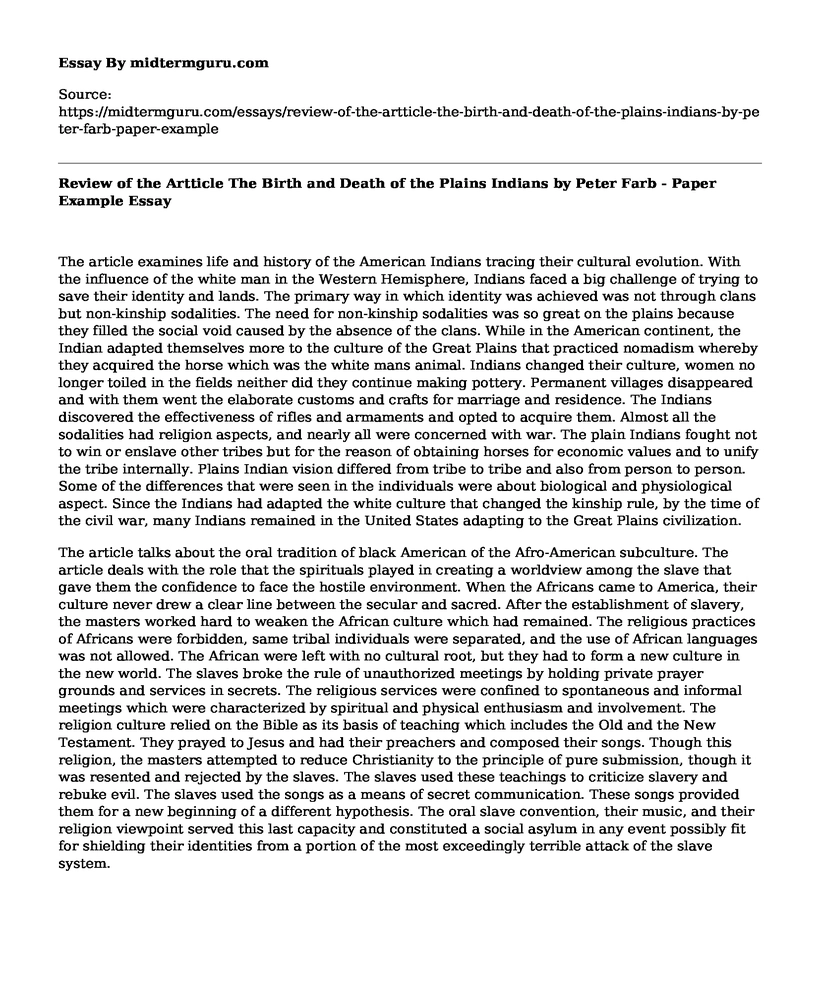The article examines life and history of the American Indians tracing their cultural evolution. With the influence of the white man in the Western Hemisphere, Indians faced a big challenge of trying to save their identity and lands. The primary way in which identity was achieved was not through clans but non-kinship sodalities. The need for non-kinship sodalities was so great on the plains because they filled the social void caused by the absence of the clans. While in the American continent, the Indian adapted themselves more to the culture of the Great Plains that practiced nomadism whereby they acquired the horse which was the white mans animal. Indians changed their culture, women no longer toiled in the fields neither did they continue making pottery. Permanent villages disappeared and with them went the elaborate customs and crafts for marriage and residence. The Indians discovered the effectiveness of rifles and armaments and opted to acquire them. Almost all the sodalities had religion aspects, and nearly all were concerned with war. The plain Indians fought not to win or enslave other tribes but for the reason of obtaining horses for economic values and to unify the tribe internally. Plains Indian vision differed from tribe to tribe and also from person to person. Some of the differences that were seen in the individuals were about biological and physiological aspect. Since the Indians had adapted the white culture that changed the kinship rule, by the time of the civil war, many Indians remained in the United States adapting to the Great Plains civilization.
The article talks about the oral tradition of black American of the Afro-American subculture. The article deals with the role that the spirituals played in creating a worldview among the slave that gave them the confidence to face the hostile environment. When the Africans came to America, their culture never drew a clear line between the secular and sacred. After the establishment of slavery, the masters worked hard to weaken the African culture which had remained. The religious practices of Africans were forbidden, same tribal individuals were separated, and the use of African languages was not allowed. The African were left with no cultural root, but they had to form a new culture in the new world. The slaves broke the rule of unauthorized meetings by holding private prayer grounds and services in secrets. The religious services were confined to spontaneous and informal meetings which were characterized by spiritual and physical enthusiasm and involvement. The religion culture relied on the Bible as its basis of teaching which includes the Old and the New Testament. They prayed to Jesus and had their preachers and composed their songs. Though this religion, the masters attempted to reduce Christianity to the principle of pure submission, though it was resented and rejected by the slaves. The slaves used these teachings to criticize slavery and rebuke evil. The slaves used the songs as a means of secret communication. These songs provided them for a new beginning of a different hypothesis. The oral slave convention, their music, and their religion viewpoint served this last capacity and constituted a social asylum in any event possibly fit for shielding their identities from a portion of the most exceedingly terrible attack of the slave system.
Cite this page
Review of the Artticle The Birth and Death of the Plains Indians by Peter Farb - Paper Example. (2021, Jun 17). Retrieved from https://midtermguru.com/essays/review-of-the-artticle-the-birth-and-death-of-the-plains-indians-by-peter-farb-paper-example
If you are the original author of this essay and no longer wish to have it published on the midtermguru.com website, please click below to request its removal:
- Essay Sample on Abraham Lincoln And The Issue In The Civil War
- Paper Example on History of Mary Prince
- Critical Essay on Twelve Years a Slave by Solomon Northup
- American Civil War: A Series of Events That Led to War - Essay Sample
- Learning US History: From Gilded Age to Present Day - Essay Sample
- Unveiling Jesus & His Followers in the Roman Empire - Essay Sample
- Paper Example on Renaissance: Michelangelo







